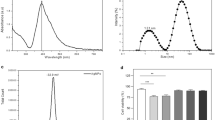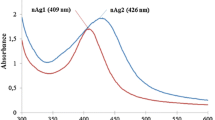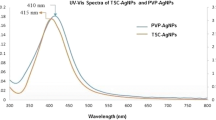Abstract
The selection of effective antibiotics is becoming increasingly limited due to the emergence of bacterial resistance. Designing and developing nanoscale antibacterials is a strategy for effectively addressing the antibiotic crisis. In this work, AgNPs@AMP nanoparticles were synthesized to take advantage of the synergistic antibacterial activity of the (LLRR)3 antimicrobial peptide (AMP) and silver nanoparticles (AgNPs). Based on morphological structure characterization and biocompatibility analysis, the inhibitory properties of AgNPs@AMP on Escherichia coli (E. coli) and Staphylococcus aureus (S. aureus) were evaluated. The results demonstrated that AMP and AgNPs were physically bound to form AgNPs@AMP nanoparticles, which had better solution stability, improved nanomaterial properties, and overcame the hemolytic activity of AMP and the cytotoxicity of AgNPs. The inhibitory activity of AgNPs@AMP against E. coli and S. aureus was significantly higher than that of AMP and AgNPs. It was capable of disrupting the morphology and internal structure of cells, damaging the cell membrane, and inhibiting the activity of enzymes related to the material-energy metabolism of the tricarboxylic acid cycle. Compared to AMP and AgNPs, AgNPs@AMP were found to effectively inhibit the infection of mouse wounds and promote their healing. Therefore, AMP-modified AgNPs can enhance their biocompatibility and antibacterial activity, and they can be further developed as a potential antimicrobial agent.
Graphical abstract










Similar content being viewed by others
Data availability
The data that support the findings of this study are available on request from the corresponding author.
References
Ali W, Elsahn A, Ting DSJ, Dua HS, Mohammed I (2022) Host defence peptides: a potent alternative to combat antimicrobial resistance in the era of the COVID-19 pandemic. Antibiotics 11(4):475. https://doi.org/10.3390/antibiotics11040475
Arakha M, Saleem M, Mallick BC, Jha S (2015) The effects of interfacial potential on antimicrobial propensity of ZnO nanoparticle. Sci Rep 5:9578. https://doi.org/10.1038/srep09578
Beurton J, Lavalle P, Pallotta A, Chaigneau T, Clarot I, Boudier A (2020) Design of surface ligands for blood compatible gold nanoparticles: effect of charge and binding energy. Int J Pharm 580:119244. https://doi.org/10.1016/j.ijpharm.2020.119244
Braz VS, Melchior K, Moreira CG (2021) Escherichia coli as a multifaceted pathogenic and versatile bacterium. Front Cell Infect Microbiol 10:548492. https://doi.org/10.3389/fcimb.2020.548492
Browne K, Chakraborty S, Chen RX, Willcox MD, Black DS, Walsh WR, Kumar N (2020) A new era of antibiotics: the clinical potential of antimicrobial peptides. Int J Mol Sci 21(19):7047. https://doi.org/10.3390/ijms21197047
Cai Z, Dai Q, Guo Y, Wei Y, Wu M, Zhang H (2019) Glycyrrhiza polysaccharide-mediated synthesis of silver nanoparticles and their use for the preparation of nanocomposite curdlan antibacterial film. Int J Biol Macromol 141:422–430. https://doi.org/10.1016/j.ijbiomac.2019.09.018
Cao HL, Qin H, Li YS, Jandt KD (2021) The action-networks of nanosilver: bridging the gap between material and biology. Adv Healthcare Mater 10(8):e2100619. https://doi.org/10.1002/adhm.202100619
Christopher FC, Ponnusamy SK, Ganesan JJ, Ramamurthy R (2019) Investigating the prospects of bacterial biosurfactants for metal nanoparticle synthesis—a comprehensive review. IET Nanobiotechnol 13(3):243–249. https://doi.org/10.1049/iet-nbt.2018.5184
Dai JH, Liu DF, Chen LJ, Sun LX (2020) Effect of Ag-1031 on apoptosis in gastric cancer AGS cells and its effects on the PI3K/AKT/mTOR signaling pathway. Biotechnol Lett 42(11):2447–2452. https://doi.org/10.1007/s10529-020-02954-6
Del Giudice P (2020) Skin infections caused by Staphylococcus aureus. Acta Derm-Venereol. 100(9):adv00110. https://doi.org/10.2340/00015555-3466
Drayton M, Kizhakkedathu JN, Straus SK (2020) Towards robust delivery of antimicrobial peptides to combat bacterial resistance. Molecules 25(13):3048. https://doi.org/10.3390/molecules25133048
Ducarmon QR, Kuijper EdJ, Olle B (2021) Opportunities and challenges in development of live biotherapeutic products to fight infections. J Infect Dis 223(12 Suppl 2):S283–S289. https://doi.org/10.1093/infdis/jiaa779
Elemam NM, Ramakrishnan RK, Hundt JE, Halwani R, Maghazachi AA, Hamid Q (2021) Innate lymphoid cells and natural killer cells in bacterial infections: function, dysregulation, and therapeutic targets. Front Cell Infect Microbiol 11:733564. https://doi.org/10.3389/fcimb.2021.733564
Fanoro OT, Oluwafemi OS (2020) Bactericidal antibacterial mechanism of plant synthesized silver gold and bimetallic nanoparticles. Pharmaceutics 12(11):1044. https://doi.org/10.3390/pharmaceutics12111044
Fu W, Shao ZL, Sun XJ, Zhou C, Xu ZP, Zhang Y, Cheng JG, Li Z, Shao XH (2022) Reversible regulation of succinate dehydrogenase by tools of photopharmacology. J Agric Food Chem 70(14):4279–4290. https://doi.org/10.1021/acs.jafc.1c08198
Gao JY, Na HY, Zhong RB, Yuan M, Guo J, Zhao LJ, Wang Yu, Wang LP, Zhang F (2020) One step synthesis of antimicrobial peptide protected silver nanoparticles: The core-shell mutual enhancement of antibacterial activity. Colloids Surf B 186:110704. https://doi.org/10.1016/j.colsurfb.2019.110704
Garcia A, Fox JG (2021) A one health perspective for defining and deciphering Escherichia coli pathogenic potential in multiple hosts. Comp Med 71(1):3–45. https://doi.org/10.30802/AALAS-CM-20-000054
Gomaa EZ (2017) Silver nanoparticles as an antimicrobial agent: a case study on Staphylococcus aureus and Escherichia coli as models for gram-positive and gram-negative bacteria. J Gen Appl Microbiol 63(1):36–43. https://doi.org/10.2323/jgam.2016.07.004
Gomes LC, Mergulhao FJ (2017) SEM analysis of surface impact on biofilm antibiotic treatment. Scanning 2017:2960194. https://doi.org/10.1155/2017/2960194
Haidari H, Bright R, Strudwick XL, Garg S, Vasilev K (2021) Multifunctional ultrasmall AgNP hydrogel accelerates healing of S. aureus infected wounds. Acta Biomate 128:420–434. https://doi.org/10.1016/j.actbio.2021.04.007
Hochvaldová L, Večeřová R, Kolář M, Prucek R, Kvítek L, Lapčík L, Panáček A (2022) Antibacterial nanomaterials: upcoming hope to overcome antibiotic resistance crisis. Nanotechnol Rev 11(1):1115–1142. https://doi.org/10.1515/ntrev-2022-0059
Jiang YJ, Chen YY, Song ZY, Tan ZZ, Cheng JJ (2021) Recent advances in design of antimicrobial peptides and polypeptides toward clinical translation. Adv Drug Delivery Rev 170:261–280. https://doi.org/10.1016/j.addr.2020.12.016
Jiang WJ, Zhang TT, Wang JW, Cheng W, Lu T, Yan YK, Tang XR (2023) Design, synthesis, inhibitory activity, and molecular modeling of novel pyrazole-furan/thiophene carboxamide hybrids as potential fungicides targeting succinate dehydrogenase. J Agric Food Chem 71(1):729–738. https://doi.org/10.1021/acs.jafc.2c05054
Joudeh N, Linke D (2022) Nanoparticle classification, physicochemical properties, characterization, and applications: a comprehensive review for biologists. J Nanobiotechnol 20(1):262. https://doi.org/10.1186/s12951-022-01477-8
Keshari A, Srivastava R, Yadav S, Nath G, Gond KK (2020) Synergistic activity of green silver nanoparticles with antibiotics. Nanomed Res J 5:44–54. https://doi.org/10.22034/nmrj.2020.01.006
Lee SH, Jun BH (2019) Silver nanoparticles: synthesis and application for nanomedicine. Int J Mol Sci 20(4):865. https://doi.org/10.3390/ijms20040865
Li TT, Liu QW, Chen HT, Li JR (2020a) Antibacterial activity and mechanism of the cell-penetrating peptide CF-14 on the gram-negative bacteria Escherichia coli. Fish Shellfish Immunol 100:489–495. https://doi.org/10.1016/j.fsi.2020.03.038
Li WX, Li YC, Sun PC, Zhang N, Zhao YD, Qin SS, Zhao YG (2020b) Antimicrobial peptide-modified silver nanoparticles for enhancing the antibacterial efficacy. RSC Adv 10(64):38746–38754. https://doi.org/10.1039/d0ra05640e
Li WZ, Song P, Xin Y, Kuang Z, Liu Q, Ge F, Zhu LB, Zhang XG, Tao YG, Zhang WW (2021) The effects of luminescent CdSe quantum dot-functionalized antimicrobial peptides nanoparticles on antibacterial activity and molecular mechanism. Int J Nanomed 16:1849–1867. https://doi.org/10.2147/IJN.S295928
Li A, Shi C, Qian S, Wang Z, Zhao SG, Liu Y, Xue ZL (2022) Evaluation of antibiotic combination of Litsea cubeba essential oil on Vibrio parahaemolyticus inhibition mechanism and anti-biofilm ability. Microb Pathog 168:105574. https://doi.org/10.1016/j.micpath.2022.105574
Li GY, Lai ZH, Shan AS (2023) Advances of antimicrobial peptide-based biomaterials for the treatment of bacterial infections. Adv Sci 10(11):e2206602. https://doi.org/10.1002/advs.202206602
Luna-Vázquez-Gómez R, Arellano-García ME, Toledano-Magaña Y, García-Ramos JC, Radilla-Chávez P, Salas-Vargas DS, Casillas-Figueroa F, Ruiz-Ruiz B, Pestryakov A, Bogdanchikova N (2022) Bell shape curves of hemolysis induced by silver nanoparticles: review and experimental assay. Nanomaterials 12(7):1066. https://doi.org/10.3390/nano12071066
Luo Y, Song YZ (2021) Mechanism of antimicrobial peptides: antimicrobial, anti-inflammatory and antibiofilm activities. Int J Mol Sci 22(21):11401. https://doi.org/10.3390/ijms222111401
Ma YH, Cai FH, Li YY, Chen JH, Han F, Lin WQ (2020) A review of the application of nanoparticles in the diagnosis and treatment of chronic kidney disease. Bioact Mater 5(3):732–743. https://doi.org/10.1016/j.bioactmat.2020.05.002
Magda F, Maria O, Marta S, Silva M, Gil S, Tavares L, Aires-da-Silva F, Gaspar MM, Aguiar SI (2021) Liposomes as antibiotic delivery systems: a promising nanotechnological strategy against antimicrobial resistance. Molecules 26(7):2047. https://doi.org/10.3390/molecules26072047
Muchintala D, Suresh V, Raju D, Sashidhar RB (2020) Synthesis and characterization of cecropin peptide-based silver nanocomposites: its antibacterial activity and mode of action. Mater Sci Eng C 110:110712. https://doi.org/10.1016/j.msec.2020.110712
Neves ACO, Viana Anderson D, Menezes FG, Wanderlei Neto AO, Melo MCN (2021) Biospectroscopy and chemometrics as an analytical tool for comparing the antibacterial mechanism of silver nanoparticles with popular antibiotics against Escherichia coli. Spectrochim Acta Part A 253:119558. https://doi.org/10.1016/j.saa.2021.119558
Ni Y, Fan JR, Hu YC (2011) Numerical study of instability of nanofluids: the coagulation effect and sedimentation effect. Nanoscale Res Lett 6(1):183. https://doi.org/10.1186/1556-276X-6-183
Noga M, Milan J, Frydrych A, Jurowski K (2023) Toxicological aspects, safety assessment, and green toxicology of silver nanoparticles (AgNPs)-critical review: state of the art. Int J Mol Sci 24(6):5133. https://doi.org/10.3390/ijms24065133
Reichelt S, Gorokhova E (2020) Micro-and nanoplastic exposure effects in microalgae: a meta-analysis of standard growth inhibition tests. Front Env Sci 8:131. https://doi.org/10.3389/fenvs.2020.00131
Saebo IP, Bjoras M, Franzyk H, Helgesen E, Booth JA (2023) Optimization of the hemolysis assay for the assessment of cytotoxicity. Int J Biol Macromol 24(3):2914. https://doi.org/10.3390/ijms24032914
Salleh A, Naomi R, Utami ND, Mohammad AW, Mahmoudi E, Mustafa N, Fauzi MB (2020) The potential of silver nanoparticles for antiviral and antibacterial applications: a mechanism of action. Nanomaterials 10(8):1566. https://doi.org/10.3390/nano10081566
Schmit T, Klomp M, Khan MN (2021) An overview of flow cytometry: its principles and applications in allergic disease research. Methods Mol Biol 2223:169–182. https://doi.org/10.1007/978-1-0716-1001-5_13
Shailaja A, Bruce TF, Gerard P, Powell RR, Pettigrew CA, Kerrigan JL (2022) Comparison of cell viability assessment and visualization of Aspergillus niger biofilm with two fluorescent probe staining methods. Biofilm 4:100090. https://doi.org/10.1016/j.bioflm.2022.100090
Sun HN, Jiang CJ, Wu L, Zhai SM (2019) Cytotoxicity-related bioeffects induced by nanoparticles: the role of surface chemistry. Front Bioeng Biotech 7:414. https://doi.org/10.3389/fbioe.2019.00414
Sun J, Kroeger JL, Markowitz J (2021) Introduction to multiparametric flow cytometry and analysis of high-dimensional Data. Methods Mol Biol 2194:239–253. https://doi.org/10.1007/978-1-0716-0849-4_13
Takahashi-Iniguez T, Aburto-Rodriguez N, Vilchis-Gonzalez AL, Flores ME (2016) Function, kinetic properties, crystallization, and regulation of microbial malate dehydrogenase. J Zhejiang Univ Sci B 17(4):247–261. https://doi.org/10.1631/jzus.B1500219
Todisco S, Convertini P, Iacobazzi V, Infantino V (2019) TCA cycle rewiring as emerging metabolic signature of hepatocellular carcinoma. Cancers 12(1):68. https://doi.org/10.3390/cancers12010068
Tong SYC, Mora J, Bowen AC, Cheng MP, Nick D, Goodman AL (2022) The staphylococcus aureus network adaptive platform trial protocol: new tools for an old foe. Clin Infect Dis 75(11):2027–2034. https://doi.org/10.1093/cid/ciac476
Vanti GL, Masaphy S, Kurjogi M, Chakrasali S, Nargund VB (2020) Synthesis and application of chitosan-copper nanoparticles on damping off causing plant pathogenic fungi. Int J Biol Macromol 156:1387–1395. https://doi.org/10.1016/j.ijbiomac.2019.11.179
Wahab MA, Li LM, Li HM, Abdala A (2021) Silver nanoparticle-based nanocomposites for combating infectious pathogens: recent advances and future prospects. Nanomaterials 11(3):581. https://doi.org/10.3390/nano11030581
Wang TR, Zou CB, Wen N, Liu XD, Meng Z, Feng SL, Zheng ZB, Meng QB, Wang CH (2021) The effect of structural modification of antimicrobial peptides on their antimicrobial activity, hemolytic activity, and plasma stability. J Pept Sci 27(5):e3306. https://doi.org/10.1002/psc.3306
Wang R, Li R, Zheng P, Yang Z, Qian C, Wang Z, Qian S (2023) Silver nanoparticles modified with Polygonatum sibiricum polysaccharide improve biocompatibility and infected wound bacteriostasis. J Microbiol 61(5):543–558. https://doi.org/10.1007/s12275-023-00042-8
Wiradharma N, Khoe U, Hauser CAE, Seow SV, Zhang SG (2011) Synthetic cationic amphiphilic α-helical peptides as antimicrobial agents. Biomaterials 32(8):2204–2212. https://doi.org/10.1016/j.biomaterials.2010.11.054
Xiong JR, Cai XY, Ge J (2022) Enzyme-metal nanocomposites for antibacterial applications. Particuology 64:134–139. https://doi.org/10.1016/j.partic.2021.02.003
Zhang QY, Yan ZB, Meng YM, Hong XY, Shao G, Ma JJ, Cheng XR, Liu J, Kang J, Fu CY (2021) Antimicrobial peptides: mechanism of action, activity and clinical potential. Mil Med Res 8(1):48. https://doi.org/10.1186/s40779-021-00343-2
Zhang J, Wang F, Yalamarty SSK, Filipczak N, Jin Y, Li X (2022a) Nano silver-induced toxicity and associated mechanisms. Int J Nanomed 17:1851–1864. https://doi.org/10.2147/IJN.S355131
Zhang L, Qin M, Yin J, Liu X, Zhou J, Zhu Y, Liu Y (2022b) Antibacterial activity and mechanism of ginger extract against Ralstonia solanacearum. J Appl Microbiol 133(4):2642–2654. https://doi.org/10.1111/jam.15733
Funding
The authors acknowledge financial support from the Scientific Research Project of Colleges and Universities in Anhui Province (NOs. KJ2021A0840; KJ2020A0374; YJS20210451), and the scientific research fund for key projects of Wannan Medical College (NO. wk2021z20).
Author information
Authors and Affiliations
Contributions
RL and JM: have equally contributed to this work. Material preparation, data collection and analysis were performed by RL, JM, RW and ZY. The first draft of the manuscript was written by JM and PZ, and the final draft of the manuscript was written and corrected by SH and RL. All authors commented on previous versions of the manuscript. All authors read and approved the final manuscript.
Corresponding author
Ethics declarations
Conflict of interest
The authors declare that there are no conflicts of interest.
Additional information
Publisher's Note
Springer Nature remains neutral with regard to jurisdictional claims in published maps and institutional affiliations.
Supplementary Information
Below is the link to the electronic supplementary material.
Rights and permissions
Springer Nature or its licensor (e.g. a society or other partner) holds exclusive rights to this article under a publishing agreement with the author(s) or other rightsholder(s); author self-archiving of the accepted manuscript version of this article is solely governed by the terms of such publishing agreement and applicable law.
About this article
Cite this article
Li, R., Mao, J., Zheng, P. et al. Improving the biocompatibility and antibacterial efficacy of silver nanoparticles functionalized with (LLRR)3 antimicrobial peptide. World J Microbiol Biotechnol 40, 1 (2024). https://doi.org/10.1007/s11274-023-03792-0
Received:
Accepted:
Published:
DOI: https://doi.org/10.1007/s11274-023-03792-0




